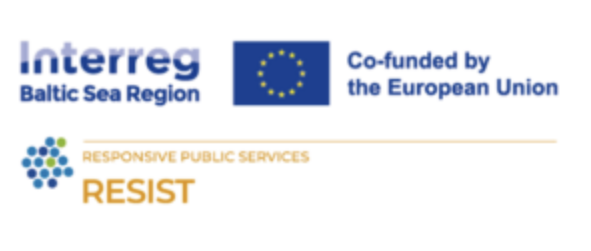RESIST
Regional Ecosystems for Social Innovation and Social Transformation
The long-term goal of the RESIST project is to increase the number of Social and Solidarity Economy Initiatives in the Baltic Sea Region and to facilitate their cooperation. Throughout the process, the involved regions will gather ideas and recommendations to better integrate Social Innovation into their local Innovation Strategies. The aim is to help institutions create better and more supportive Regional Ecosystems for Social innovation and Social Entrepreneurship.
Project partners will explore the concept of Social and Ecological innovation clusters (CSEI) as a model to promote cross-sector collaboration. They will develop and test a program to enhance the capacity of innovation-supporting stakeholders in promoting social innovation. The network to be established will start as informal cooperation among the partner regions piloting the CSEI model, newly established coordinating centers/cluster organizations, and existing CSEIs in the Baltic Sea Region. Examples include the Partnership for Social Innovation in Region Örebro län in Sweden and the Lithuanian Social Innovation Cluster. Over time, the network intends to expand its membership and evolve into a more formal organization with a memorandum of understanding to regulate cooperation and official membership.
The network's chairmanship will likely rotate regularly among the participating CSEIs, ensuring that staff resources for the network's continuation after the project's end are available in various organizations.
The ultimate goal is to adapt and implement the relatively new concept of "Social and Ecological Innovation Clusters," developed and promoted by the European Commission's GECES working group. The outcome will be a model for social and ecological innovation clusters (CSEI) in the Baltic Sea Region, which organizations from any sector can follow to create a similar network or coordinating body for the Social Economy, Social Innovation, and/or Social Entrepreneurship. Like traditional clusters, CSEIs aim to strengthen collaboration among different stakeholders and create a supportive Ecosystem for innovation in a specific region. However, CSEIs have distinguishing features:
- They are organized cross-sectorally rather than focusing on a specific sector or branch.
- They use a quadruple or quintuple helix model, incorporating civil society along with the public sector, academia, and businesses.
- Their primary goal is not to increase regional competitiveness but to find solutions to social and ecological challenges and to strengthen social cohesion.
It is important to note that Social Economy Clusters can also have significant economic impact, as social enterprises create jobs and often improve the living standards of citizens, especially marginalized groups.
According to the GECES working group definition, CSEIs should have a membership model (formal, informal, or open) and a cluster organization/coordinating body. It is worth mentioning that CSEIs do not necessarily need to be called Clusters, nor do their coordinating bodies need to be called Cluster Organizations. They can essentially be Social Enterprise Alliances, Social Economy Support Networks, Philanthropic Associations, or Public Sector Social Innovation Platforms.
The result will be three interrelated components, all highly valuable to the initiators of new CSEIs in the Baltic Sea Region:
- A prototype CSEI structure, i.e., a model for the CSEI and its coordinating body/cluster organization’s operational concept, membership structure, and funding.
- A mission design guide to help CSEI coordinating bodies (and others) implement mission-oriented innovation policy, a tool for setting a cross-sectoral collaboration agenda in social innovation.
- An impact measurement framework to help CSEI coordinators and involved parties assess the effectiveness of CSEI support in generating innovation and achieving social and ecological goals.
The particular suitability of CSEIs for international cooperation lies in their non-competitive nature. Clusters or cluster members involved in international knowledge exchange and transfer do not have to fear competition from any other region - they only benefit from cooperation. CSEIs can register on the European Cluster Collaboration Platform as clusters.
The project is led by the city of Hamburg (Germany). A total of 14 main partners and 16 associated organizations from eight different countries, including Germany, Poland, Latvia, Lithuania, Sweden, Norway, Finland, and Estonia, are participating in the project.
Tallinn University is responsible for developing cross-sectoral social innovation objectives (A1.2) and assessing the impact of support services for social innovation and social entrepreneurship (A1.5). Tallinn University’s role is to support Võrumaa Development Center and other partners in building the ecosystem, developing social and ecological innovation clusters, initiating prototypes, and supporting Malmö University’s activities in developing the strategy lab methodology for all partners. Together with DCVC, Tallinn University will establish a national strategy lab addressing Estonia’s RIS3 and will relay the project results to the Social Innovation Competence Center in Estonia.
Funding: The project is funded by the European Commission through Interreg Baltic Sea Region, with a total budget of 3,621,705 euros, of which Tallinn University’s share is 122,800 euros.
Duration: Activities will be carried out from November 2023 to October 2026.
Project Manager: Associate Professor Katri-Liis Lepik, Tallinn University, School of Governance, Law and Society.
